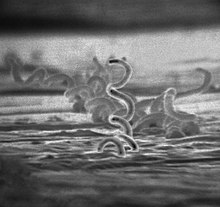Meningeal syphilis
Treponema pallidum, a spirochate bacterium, is the main cause of syphilis, which spreads drastically throughout the body and can infect all its systems if not treated appropriately.
If syphilis is not treated, the disease can affect various other systems in the body, including the brain, heart, and vessels.
[5] Meningitis inflames and breaks down any protective membrane and cells surrounding the brain, spinal cord, and other parts of the nervous system.
[7] Syphilis is a sexually transmitted infection that is brought upon by the gram negative bacteria, Treponema pallidum.
Some distinguishing features of the bacteria include a thin spirochete, which is not reliably seen on gram stain.
Usually within two to twelve weeks, a red, circular sore (which is known as a chancre) is present where the bacteria first entered the body.
Commonly, these chancres are visible on the penis, anus, rectum, vagina, and cervix; however, they are usually difficult to identify even though it is a localized disease.
The lesion does not induce any pain; however, it can lead to an ulcer that can secrete mucus, swelling, or tenderness in the infected area.
The diagnosis can include dark-field or fluorescent microscopy of lesion; however, fifty percent of patients will be negative by nonspecific serology.
[citation needed] The secondary stages of syphilis persists to be more dangerous to the systems of the human body.
Generally, rashes may start developing on the hands and soles of the feet, and it can spread to various parts of skin on the body.
Other symptoms may include sore throat, headache, joint pain, fever, and patches of hair loss.
This stage is highly dangerous because the symptoms altogether disappear and remain hidden for a prolonged period of time.
Neurosyphilis at this point can cause several damages to the body, including tabes dorsalis.
[11] When the nervous system is infected at this particular stage, the individual is at risk for meningeal syphilis, which in turn slowly shuts down the entire body.
Dark field microscopy initially had the finding that the spirochete has a corkscrew appearance and that it is spirillar and gram (-) bacteria.
[12] The Nontreponemal antibody test screens with VDRL (Venereal Disease Research Lab) and RPR (Rapid Plasma Reagin).
[13] Brain imaging and MRI scans may be used when diagnosing patients; however, they do not prove to be as effective as specific tests.
Prevention of syphilis includes avoiding contact of bodily fluids with an infected person.
This can be particularly difficult because syphilis is usually transmitted by people who are unaware that they have the disease because they do not have any visible sores or rashes that may denote having an infection in general.
Transmission can occur through any form of sexual contact, including vaginal, anal, oral, and manual sex.






